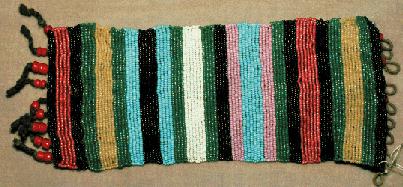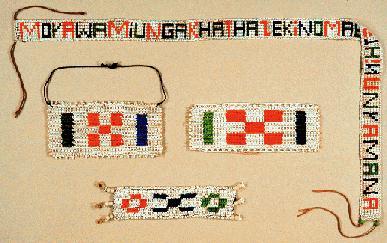Chromography with beads
Botschaften kodiert in farbigen Perlen |
back to
Seibt |
As an example of traditional symbolic message notation in a pre-literate culture we analyzed over 400 beadwork items of a South African Bantu (Nguni) tribe, the amaMchunu people in Natal. We discovered, that their "isishunka" colour-sequence comprises 7 defined colours on 17 positions: sooty - red - sooty - green - yellow - green - blue - sooty - blue - green - white - green - sooty - pink - blue - pink - green.
Each colour represents a special statement. Every beadwork item contains a selection of statements using a corresponding part of this sequence. |
 "Isishunka"-wristband with part of the sequence repeated, emphazising the
respective statements.
"Isishunka"-wristband with part of the sequence repeated, emphazising the
respective statements.
© Seibt |
|
Around 1950, the colour-coded beadwork began to be invaded by letters of our Latin alphabet, used first as ornaments, then as graphemes to write words with beads. We collected the available interpreted colour coded messages and more than 100 beaded texts for a comparative structural and semantic analysis. Many texts written with beads are verbal equivalents of the old colour-coded messages. There are even detailed parallels between colour-coded and alphabetic statements covering the traditional situations between female and male partners prior to marriage and in later family life.
|
 Belt telling: "My spirit
does not worry; it does not matter what the horrible people say".
Belt telling: "My spirit
does not worry; it does not matter what the horrible people say".
A traditional colour sequence is still followed letter by letter.
© Seibt |
|
This process of alphabetization turned out to be the first fully documented transition from pre-literate message notation to true writing in a contemporary human population. Bead literacy in these peoples illustrates both, advantages and shortcomings of superseding a traditional coding system by the western alphabet.
|
Literature
Wickler, Wolfgang und Seibt, Uta 2006: Ein Übergang vom Farben-Code zum Alphabet bei den Zulus in Südafrika. Zur Übergabe der Sammlung "Südafrikanische Perlenarbeiten" an das Staatliche Museum für Völkerkunde München. In: Jahrbuch des Staatlichen Museums für Völkerkunde München Band 10, p. 147-159
Verlag des Staatlichen Museums für Völkerkunde München ISBN 978-927270-50-3
Wickler, Wolfgang und Seibt, Uta 2002: Kalenderworm en Kralenpost. Biologische verklaringen voor ongeschreven cultuurfenomenen. Natuur & Techniek Veen Magazines, Amsterdam, pp. 209 ISBN 90-76988-10-2
Wickler, Wolfgang und Seibt, Uta 2001: Perlensprache In: Das Afrika Lexikon. Ein Kontinent in 1000 Stichworten. (Mabe, F.E. ed.) Peter Hammer & J.B. Metzler Verlage Stuttgart, 491-492
Wickler, Wolfgang & Seibt, Uta 2000: Des messages codés en perles de couleurs. Dossier pour la Science (Edition Française de Scientific American) 2000, 124-130
Wickler, Wolfgang & Seibt, Uta 1998: Kalenderwurm und Perlenpost. Biologen entschlüsseln ungeschriebene Botschaften. Spektrum Akademischer Verlag, Heidelberg, Berlin pp. 217
Wickler, Wolfgang & Seibt, Uta 1996: Zulu Beadwork messages: Chromographic versus alphabetic notation. Baessler Archiv Neue Folge 44, 23-75
Wickler, Wolfgang & Seibt, Uta 1995: Syntax and semantics in a Zulu bead-colour communication system. Anthropos 90, 391-405
Wickler, Wolfgang & Seibt, Uta 1994: Vom Farben-Code zur Schriftsprache bei den Zulus. pp 299-312 In: Kultur-Ethologie (M. Liedtke ed.), Realis Verlag, München
Wickler, Wolfgang & Seibt, Uta 1994: Colour-coded Zulu bead-language and a European medieval equivalent. Baessler-Archiv Neue Folge 42, 61-73
Wickler, Wolfgang & Seibt, Uta 1991: Structural and semantic constituents of Mchunu bead language; Msinga district, Natal, South Africa. Baessler-Archiv Neue Folge 39, 307-344
Wickler, Wolfgang & Seibt, Uta 1990: Zulu bead-language and its present alphabetization. Baessler-Archiv Neue Folge 38, 65-115
Wickler, Wolfgang & Seibt, Uta 1990: Liebesbriefe in Farben. Spektrum der Wissenschaft 1990 (9), 124-136
Wickler, Wolfgang & Seibt, Uta 1989: Studies in Bantu peoples' bead-language: A special colour convention from Msinga District (Natal, South Africa). Baessler-Archiv Neue Folge 37, 315-328
 "Isishunka"-wristband with part of the sequence repeated, emphazising the
respective statements.
"Isishunka"-wristband with part of the sequence repeated, emphazising the
respective statements. Belt telling: "My spirit
does not worry; it does not matter what the horrible people say".
Belt telling: "My spirit
does not worry; it does not matter what the horrible people say".